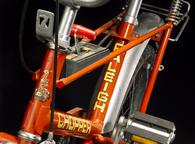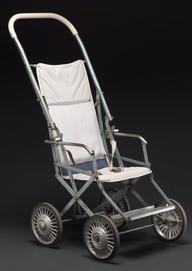

Norwegian Carriole
- Made:
- Unknown in Norway
This Norwegian cariole is a two wheeled, one seat cart designed to be pulled by a single horse. It was built by an unknown maker at an unknown date in Norway before being shipped to the UK during the Victorian era (1837-1901).
The carriole has a single black leather seat, which is supported by a wooded frame and shafts. The frame and shafts of this vehicle were originally painted black (which has since flaked off). The frame and shafts are separated from the driver’s seat by two elliptical springs. There are no brakes for this vehicle.
Carrioles originate from the rural areas of Norway, and are closely related to gigs, chaises, and other light framed, two wheeled, one seat carriages. These small, lightweight carriages were drawn by a single horse or pony.
Carrioles typically do not have springs and the single occupant usually sits with their legs almost out straight in front of them. Different variants of carrioles came with other features, sometimes having four wheels, hoods and springs. It was also very common for carrioles (especially those found in rural Norway) to be fitted with sleds rather than wheels.
These vehicles were popular throughout the 18th and 19th century.
This particular carriole was owned by the British royal family. It is unusual in that it has suspension, and a seat that allowed a driver to sit upright rather than have their legs stretched in front of them.
Details
- Category:
- Road Transport
- Object Number:
- 1936-600
- Materials:
- wood (unidentified), paint, metal (unknown) and leather
- Measurements:
-
overall: 1600 mm x 1040 mm x 4000 mm,
- type:
- carriole
- credit:
- H.M. King Edward VIII




